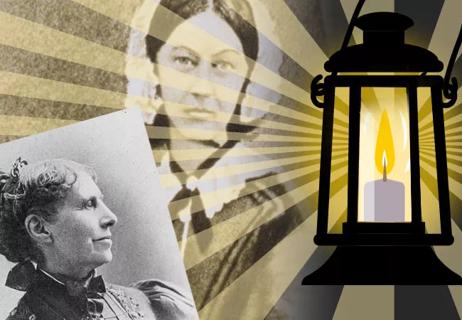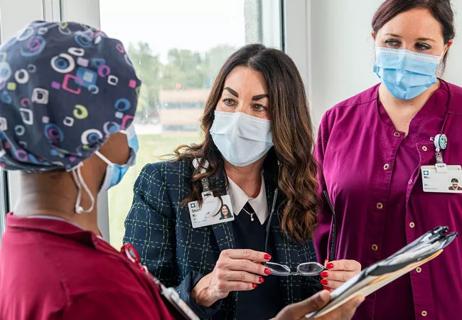Advertisement
A new age in practice, physician partnerships and more

By Shannon Pengel, MSN, RN, NE-BC, Chief Nursing Officer, Cleveland Clinic Main Campus
Advertisement
Cleveland Clinic is a non-profit academic medical center. Advertising on our site helps support our mission. We do not endorse non-Cleveland Clinic products or services. Policy
Throughout the past few decades, the role of nurses as leaders in how care is provided has been elevated significantly. With so much revolving around the role of the nurse, including identifying problems and devising solutions, quality improvement, patient safety, patient experience and more, nurses today are being viewed as leaders no matter what formal title they hold.
Driven by increased and enhanced nursing leadership throughout healthcare, nursing has taken center stage, partnering and working collaboratively with all stakeholders, physicians included, to make patient care exceptional.
In honor of Cleveland Clinic’s centennial anniversary, it is illuminating to consider how the evolution of nursing in healthcare leadership has given Cleveland Clinic nurses a more profound voice on the care team and changed the way nurses and physicians work together.
One of the most defining moments in Cleveland Clinic nursing history came in 2008, when Cleveland Clinic announced its institute model of care. Not only was this an innovative move for the health system and the way we cared for patients, but for the first time, nursing across the health system became one unified institute under the leadership of an Executive Chief Nursing Officer (ECNO). A system-wide executive nursing team was soon formed, and by 2009, all hospital CNOs and newly appointed Associate Chief Nursing Officers (ACNOs) reported to the ECNO, who reported directly to the Chief Executive Officer (CEO).
With this new organizational structure, nursing had executive-level presence within the health system’s physician-led leadership team. Additionally, the formation of the clinical institute model created a triad of leadership – nurse, physician and administrator – in each clinical area, changing interprofessional collaboration, enhancing multi-disciplinary relationships and more.
By 2010, for example, Cleveland Clinic physician and nurse leaders had formed a workgroup called the physician/nurse (MD/RN) collaboration program. It included focus groups and pilot programs that looked at role synergy, professional behaviors and respect, and collaboration around the plan of care. Focus groups had distinct objectives and action plans and were led by collaborative teams of physicians and nurses.
When Kelly Hancock, DNP, RN, NE-BC, FAAN, took over as ECNO in 2012, she paved the way for nurses to be further recognized as patient advocates and integral, leading members of the care team. The role of the nurse was changing from a traditional bedside caregiver in the hospital setting to one that encompassed direct patient care, care coordination, nursing technology, research and more in a variety of care settings.
Advertisement
It was a new age of healthcare and nurses’ expertise was being promoted and shared. Nursing leadership encouraged more and more nurses to conduct research, publish clinical findings, innovate new ideas and get involved in healthcare legislation. They developed affinity groups to drive work and collaboration for specialty nursing areas and geographic-specific nursing, as well as operational and strategic councils and teams to help lead tactical execution of established initiatives. They implemented refined accountability measures, process training and reporting structures to successfully execute initiatives, analyze progress and track imperative nursing-related metrics, working diligently to evaluate and ensure quality, safe patient care was delivered for every patient.
Cleveland Clinic’s nurse executives were leading strategy and change to advance professional nursing, nursing within Cleveland Clinic and healthcare in general. As nursing’s role in healthcare leadership increased, so did nurse/physician partnerships at every level.
Today, nurses and physicians work side-by-side across all global Cleveland Clinic locations. For example, a multidisciplinary ICU operations council leads a tremendous amount of work in enterprise ICU operations. Within the council, nurse and physician leaders continuously collaborate on practice improvements. The group meets monthly at main campus, and quarterly as an enterprise. Key topics of discussion often include standardization of order sets and protocols, cost reduction opportunities and evaluation of hospital footprints to get patients to the right location at the right time. One of the council’s primary goals is to ensure that no matter what Cleveland Clinic location or facility a patient visits, the ICU experience will be consistent, and nursing and physician roles will be the same.
Advertisement
A similar example can be found in the newly created resuscitation operations council, which is also jointly led by nurses and physicians. It is comprised of chief medical officers and chief nursing officers. I co-chair the council on behalf of nursing and Donn Marciniak, MD, co-chairs from the physician side. Collectively, we work together to standardize and improve emergency response across the health system. This includes activating emergency teams the same way at every location and reducing failure-to-rescue cases by identifying patients when they are deteriorating, getting patients care when needed, and more. The council follows an enterprise charter as well as hospital-specific charters.
Another collaborative program I helped to develop was the facilitation of the standardization of rapid response care across the health system. I worked hand-in-hand with Robert Savage, MD, to develop this program, which has evolved into a highly successful nurse/physician-run service that provides emergency care to patients suffering from rapid clinical deterioration. Nurses and physicians are also working together in the home healthcare space. In July 2020, Cleveland Clinic Home Care launched a program to reduce inappropriate emergency department utilization. The program is a collaboration among home care triage nurses and physicians on the Cleveland Clinic Community Care virtualist team.
The COVID-19 pandemic offers another notable example of nurses leading like they’ve never led before and nurses and physicians working together to face incredible challenges. Throughout the pandemic, nurses have taken on added roles and responsibilities and created innovative solutions alongside their physician partners and other care colleagues to develop plans and combat a problem that could have never been anticipated. The Cleveland Clinic stories of care collaboration are bountiful and were all made possible because leadership teams worked hard to remove barriers so caregivers could perform to the best of the abilities in an unimaginable setting.
When I look back on how far patient care at Cleveland Clinic has come because of all caregivers working together and collaborating to keep the patient at the center of our work, I am incredibly proud. As a nurse, having the opportunity to touch hundreds of thousands of lives is a great honor. And, collectively, as a team of caregivers, we’ve made huge impacts on safety and experience and continue to advance healthcare every day.
Advertisement
Advertisement

The CNO of Cleveland Clinic London shares insight and advice on international nursing

Nurses set goals for rebuilding a committee that waned during the pandemic

By listening closely and responding authentically, leaders can create an environment where nurses feel valued

Communication and self-reflection key to world-class patient care

Nurse leaders play a pivotal role in employee engagement, quality, safety – and, yes, patient care

Text highlights historic contributions to research, education and clinical care

Insights and advice from a nursing leader

Find balance, slow down, seek feedback and more